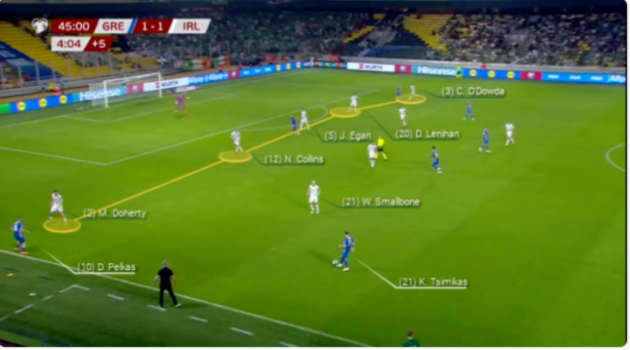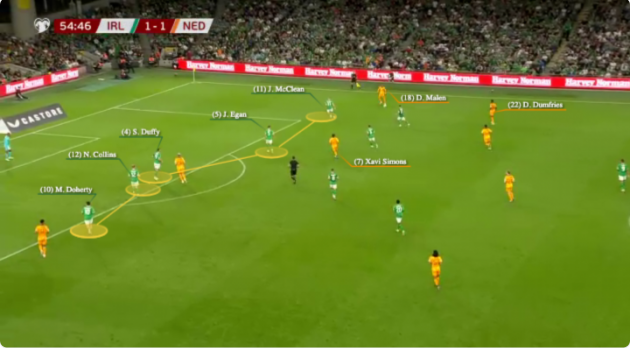IRELAND’S GOALLESS DRAW with Belgium was not the kind of game that should be subject to a days-long post-mortem: Domenico Tedesco wrote it off as “boring” and admitted he was using it as an exercise in experimentation ahead of the Euros. Hence why he changed his goalkeepers with eight minutes to go and sent Everton midfielder Amadou Onana on as a centre-back.
And if the FAI stick to their word and eject John O’Shea from the hotseat after only two games in charge, then the game offers few clues as to how Ireland will look against England in September.
O’Shea, though, wants to be a manager, so a senior international against the fourth-best side in the world makes for a pretty good audition reel. So if we can be said to have learned anything from the game about O’Shea, it is that he is governed by a healthy streak of pragmatism.
Against Belgium he took the same basic structure as Stephen Kenny built but addressed some of the flaws that arose last year, when he was on the staff as the number three.
Let’s begin with the broad strokes. O’Shea stuck with a back three, and played a kind of 3-4-2-1, which Kenny deployed in the 2-1 home defeat to the Netherlands last year. While he did hand a debut to Sammie Szmodics and picked Caoimhín Kelleher in goal, everything else was pretty familiar.
Andrew Omobamidele, Nathan Collins, and Dara O’Shea played across the back three, while the wing backs were more experienced, in the form of Seamus Coleman and Robbie Brady.
Matt Doherty made more appearances than any other player under Kenny, so the old boss might have found room for him at either wing-back position. That said, Kenny would have used Coleman and Brady much more often had it not been for their respective injury issues.
Will Smallbone and Josh Cullen played in central midfield, while Chiedozie Ogbene and Szmodics played further forward: effectively as two wide number 10s, behind Evan Ferguson. (Alternatively, think of Ferguson playing at the tip of an upside-down ‘V’.)
Szmodics was the freshest face but his role was similar to that performed for Kenny by Jamie McGrath and Jason Knight: to drop off between the lines to be a passing option to feet, and get Ireland up the pitch.
Ireland began as they often did under Kenny: aggressively, pressing high and occasionally parlaying that into shooting opportunities.
When they couldn’t quickly win the ball back, Ireland dropped and sat off, defending in a compact 5-4-1. They did this under Kenny too, but yesterday they did so with a little more conservatism, and thus sat more tightly allowing less space between the lines.
With this slight shift in mindset – and the fact it wasn’t changed by at any point by a Belgian goal – Ireland were not scythed open by their opponents as often as they were under Kenny. On the only occasion in which Belgium did manage to generate a counter-attack, Kelleher saved well from Thomas Meunier.
Youri Tielemans did occasionally ghost into space behind the Irish midfield in the first half, but he didn’t receive a pass when he did. Ireland deserve some credit for that but, equally, Tedesco chided his players for moving the ball too slowly.
“If you play slowly and pass slowly then it’s difficult”, said the Belgian boss. “It’s easy for them to move and close the spaces.”
We did see O’Shea’s stamp on the team when it came to set pieces. Defensively, Ireland marked zonally, having mixed it with some man-to-man marking under Kenny. Offensively, Ireland were even bolder on set plays, pushing everyone forward Brentford-style, neglecting to drop one or two players to the halfway line to cover counter-attacks. (This might have backfired late in the game, only for Doku to waste the counter with an awful pass.)
On the ball, there were no obvious differences between O’Shea’s team did and Kenny’s team. Ireland did go occasionally go direct to Ferguson – particularly from Kelleher – but Kenny’s team did that too. (Anyone claiming Kenny’s team were playing tiki-taka stopped watching games at the end of 2020.)
A missed penalty means Ireland naturally had reasons for regret after the game, but truthfully they didn’t create much across the full game: the penalty was their only shot on target.
Otherwise the goalscoring chances were generated much as they were under Kenny: a turnover thanks to high pressing early in the game (Ogbene’s shot into the side-netting and his flashed shot across the face of the goal); set-pieces (the award of the penalty, and then Szmodics’ shot over the bar from Ferguson’s knock-on); and a clever kick-off routine (Ferguson’s header over the bar 11 seconds after the restart.)
The most disappointing facet of the game was that Ireland’s last shot of note came in the 66th minute, despite the fact O’Shea changed his entire front three when the clock hit 70 minutes. But it’s not fair to say O’Shea simply took Kenny’s team, dropped in Szmodics, and soaked up the praise.
He did show evidence of learning and addressing its past problems.
Greece and the Netherlands both exploited a fatal problem with Kenny’s back three set-up last year: both pushed their wide players very high and very wide, in order to pin back Ireland’s wing backs, which therefore created space in midfield and exhausted Ireland’s attack-minded players. (We’ve detailed these problems a couple of times, and in most depth here.)
Here are a couple of examples from both games:
O’Shea was determined to avoid Belgium doing the same.
Tedesco did try to do so, albeit in slightly novel fashion. Winger Johan Bakoyoko kept their width on the right hand-side, with the left-back Olivier Deman pushing way forward to play as a forward. This meant Leandro Trossard, nominally playing on the left-wing, to tuck inside and find space. (Ireland’s afternoon would have been much more difficult if Kevin De Bruyne had been fit to play this role.)
Initially, that pinned Ireland’s wing backs deep, and Belgium’s best passage of possession came during this stage of the game.
O’Shea, however, wanted his wing-backs higher, as he explained post-game.
“We spoke about, don’t have three [Belgian] players holding five of us back”, he said.
“We can’t have it, because it’s going to be too hard for our front three, they were going to have to work too hard. So they needed to fix that a bit quicker in terms of communication with Andrew, Seamus and Chieo. When they fixed that, at times it was brilliant, because we were up the pitch, we were pressing higher, we were forcing Belgium back and we were picking up better positions for us when we won the ball back with our two sixes.”
And when Coleman in particular got higher, it worked. In the 23rd minute he shot up to block a pass from Deman, and Ireland then kept possession – via a few Belgian fouls – to the moment they won the penalty four minutes later.
Ogbene won the free from which Ireland forced the Belgian handball, and it was notable that Coleman was actually standing further forward when Ogbene first pounced on the ball. (Coleman himself was fouled moments earlier.)
The arrival of Jeremy Doku naturally kept Coleman pretty deep in the second half, and he slightly blemished an otherwise outstanding performance in miscontrolling a Szmodics switch of play in the second half out of play.
O’Shea is expected to make a few changes for tomorrow’s game against Switzerland, where hopefully we will see Ireland offer a more consistent attacking threat.







